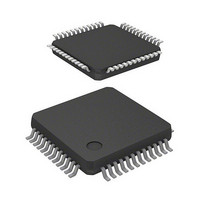LPC11C22FBD48/301, NXP Semiconductors, LPC11C22FBD48/301, Datasheet - Page 19

LPC11C22FBD48/301,
Manufacturer Part Number
LPC11C22FBD48/301,
Description
TXRX CORTEX CAN 16K FLASH
Manufacturer
NXP Semiconductors
Series
LPC11Cxxr
Datasheet
1.LPC11C14FBD48301.pdf
(61 pages)
Specifications of LPC11C22FBD48/301,
Core Processor
ARM Cortex-M0
Core Size
32-Bit
Speed
50MHz
Connectivity
CAN, CAN Transceiver, I²C, Microwire, SPI, SSI, SSP, UART/USART
Peripherals
Brown-out Detect/Reset, POR, WDT
Number Of I /o
36
Program Memory Size
16KB (16K x 8)
Program Memory Type
FLASH
Ram Size
8K x 8
Voltage - Supply (vcc/vdd)
1.8 V ~ 3.6 V
Data Converters
A/D 8x10b
Oscillator Type
Internal
Operating Temperature
-40°C ~ 85°C
Package / Case
48-LQFP
Lead Free Status / RoHS Status
Lead free / RoHS Compliant
Eeprom Size
-
Lead Free Status / Rohs Status
Compliant
Other names
568-6643
LPC11C22FBD48/301
LPC11C22FBD48/301
Available stocks
Company
Part Number
Manufacturer
Quantity
Price
Company:
Part Number:
LPC11C22FBD48/301,
Manufacturer:
NXP Semiconductors
Quantity:
10 000
NXP Semiconductors
LPC11CX2_CX4
Product data sheet
7.10.1 Features
7.11.1 Features
7.11 C_CAN controller
receivers can operate in either master or slave mode, depending on whether the chip has
to initiate a data transfer or is only addressed. The I
controlled by more than one bus master connected to it.
Controller Area Network (CAN) is the definition of a high performance communication
protocol for serial data communication. The C_CAN controller is designed to provide a full
implementation of the CAN protocol according to the CAN Specification Version 2.0B. The
C_CAN controller allows to build powerful local networks with low-cost multiplex wiring by
supporting distributed real-time control with a very high level of security.
On-chip C_CAN drivers provide an API for initialization and communication using CAN
and CANopen standards.
•
•
•
•
•
•
•
•
•
•
•
•
•
•
•
•
•
•
•
The I
I
Easy to configure as master, slave, or master/slave.
Programmable clocks allow versatile rate control.
Bidirectional data transfer between masters and slaves.
Multi-master bus (no central master).
Arbitration between simultaneously transmitting masters without corruption of serial
data on the bus.
Serial clock synchronization allows devices with different bit rates to communicate via
one serial bus.
Serial clock synchronization can be used as a handshake mechanism to suspend and
resume serial transfer.
The I
The I
Conforms to protocol version 2.0 parts A and B.
Supports bit rate of up to 1 Mbit/s.
Supports 32 Message Objects.
Each Message Object has its own identifier mask.
Provides programmable FIFO mode (concatenation of Message Objects).
Provides maskable interrupts.
Supports Disabled Automatic Retransmission (DAR) mode for time-triggered CAN
applications.
Provides programmable loop-back mode for self-test operation.
The C_CAN API includes the following functions:
– C_CAN set-up and initialization
– C_CAN send and receive messages
2
C-bus interface also supports Fast-mode Plus with bit rates up to 1 Mbit/s.
2
2
2
C-interface is a standard I
C-bus can be used for test and diagnostic purposes.
C-bus controller supports multiple address recognition and a bus monitor mode.
All information provided in this document is subject to legal disclaimers.
Rev. 2 — 3 December 2010
2
C-bus compliant interface with open-drain pins. The
32-bit ARM Cortex-M0 microcontroller
2
C is a multi-master bus and can be
LPC11Cx2/Cx4
© NXP B.V. 2010. All rights reserved.
19 of 61
















